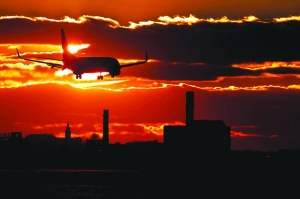Airlines’ energy transition feasible, but costs and challenges remain huge


An American Airlines flight lands at Logan International Airport in Boston, Massachusetts, US. The global airline industry will need to spend an average of $128bn in annual capital expenditure if it is to achieve its ambitious net-zero emissions goal by 2050, according to trade body IATA.
The updated ‘IATA Policy and Finance Net Zero Roadmaps’ say that decarbonisation by 2050 is indeed possible.
Success, however, would be facilitated by governments redirecting subsidies away from fossil fuels and toward renewable energy production, of which sustainable aviation fuel (SAF) is just one type of product.
Annual transition cost, meaning the cost that comes on top of that of jet fuel as a result of procuring SAF, hydrogen, and other key levers, is estimated at $1.4bn in 2025.
In 2050, the transition cost could be as high as $744bn, based on IATA’s analysis. These numbers highlight the need for speed and scale in bringing solutions to market so that net zero CO2 emissions can be achieved.
The air transport industry’s energy transition is feasible on the 2050 horizon, although, IATA says it success in the transition depends critically upon policymakers’ unity of purpose.
The association also sounds a warning bell that, to achieve this, all stakeholders, particularly policymakers, must collaborate more broadly and act with greater urgency.
Transition involves huge expenditure and is a costly affair. And transitioning to low-carbon technologies, such as SAFs, electric aircraft, or hydrogen-powered planes, requires significant investments in new infrastructure (fuelling stations, manufacturing facilities, etc.). Many airports are not equipped to handle these new technologies yet.
Industry experts say the research and development required to bring these technologies to market are costly, and airlines, already operating on thin profit margins, will face challenges funding these innovations.
Green technologies, especially SAFs, are significantly more expensive than traditional jet fuels. This price gap needs to narrow for widespread adoption, but market mechanisms to ensure affordability remain underdeveloped.
Also, the Covid-19 pandemic had severely affected the financial health of airlines, leaving many companies struggling to fund the transition to greener technologies, which are often more expensive.
“To be successful, we need clear policy and financial frameworks that will support air transportation’s needs in a way that is realistic and coherent with the massive changes that must take place simultaneously in all economic sectors,” noted Willie Walsh, IATA’s Director General.
According to IATA’s chief economist Marie Owens Thomsen, “The costs and challenges associated with the energy transition are large, but the opportunities are even greater. Countries have an opportunity to build new industries in agriculture and energy, and to benefit from the catalytic growth impact of sustainable air transport. To realise the opportunities, we need all minds to unite in this mission, and all policymakers, multilateral organisations, investors, solution providers, and the air transport industry to work together.
“Such transformative collaboration can pool resources and target meaningful action for greater impact. This is what is needed to deliver a sustainable air transport industry by 2050.”
While advancements in fuel efficiency have been made, the fact remains that the current aircraft models rely heavily on fossil fuels.
The development and widespread deployment of zero-emission aircraft, such as electric or hydrogen-powered planes, are still in the experimental or early development phases. It may take decades to bring these to market at scale.
SAFs are able to reduce emissions, but they are not yet produced at scale, and their costs too are significantly higher than traditional jet fuel. Scaling production while maintaining environmental sustainability is a huge challenge.
Aviation is a global industry, so decarbonisation efforts need international co-operation. Different countries have varying levels of commitment and regulatory environments regarding climate change, leading to inconsistent policies and goals.
These challenges highlight the complexity of achieving net-zero for the aviation industry, which will require co-ordinated efforts from governments, businesses, technology developers, and consumers.
Pratap John is Business Editor at Gulf Times. X handle: @PratapJohn



